Abstract
We examined the minimal inhibitory concentrations and minimal bactericidal concentrations of chloramphenicol, ampicillin, ticarcillin, cefamandole, cefazolin, cefoxitin, cefotaxime, ceforanide, and moxalactam for 100 isolates of Haemophilus influenzae, 25 of which produced beta-lactamase. Susceptibility was not influenced by the capsular characteristic of the organism. The mean minimal inhibitory concentrations of cefamandole, ticarcillin, and ampicillin for beta-lactamase-producing strains were 3-, 120-, and 400-fold higher than their respective mean minimal inhibitory concentrations for beta-lactamase-negative strains. No such difference was noted for the other antibiotics. We performed time-kill curve studies, using chloramphenicol, ampicillin, cefamandole, cefotaxime, and moxalactam with two concentrations of the antimicrobial agents (4 or 20 times the minimal inhibitory concentrations) and two inoculum sizes (10(4) or 10(6) colony-forming units per ml). The inoculum size had no appreciable effect on the rate of killing of beta-lactamase-negative strains. The rates at which beta-lactamase-producing strains were killed by chloramphenicol, cefotaxime, and moxalactam was not influenced by the inoculum size. Whereas cefamandole in high concentrations was able to kill at 10(6) colony-forming units/ml of inoculum, it had only a temporary inhibiting effect at low drug concentrations. Methicillin and the beta-lactamase inhibitor CP-45,899 were able to neutralize the inactivation of cefamandole by a large inoculum of beta-lactamase-producing H. influenzae.
Full text
PDF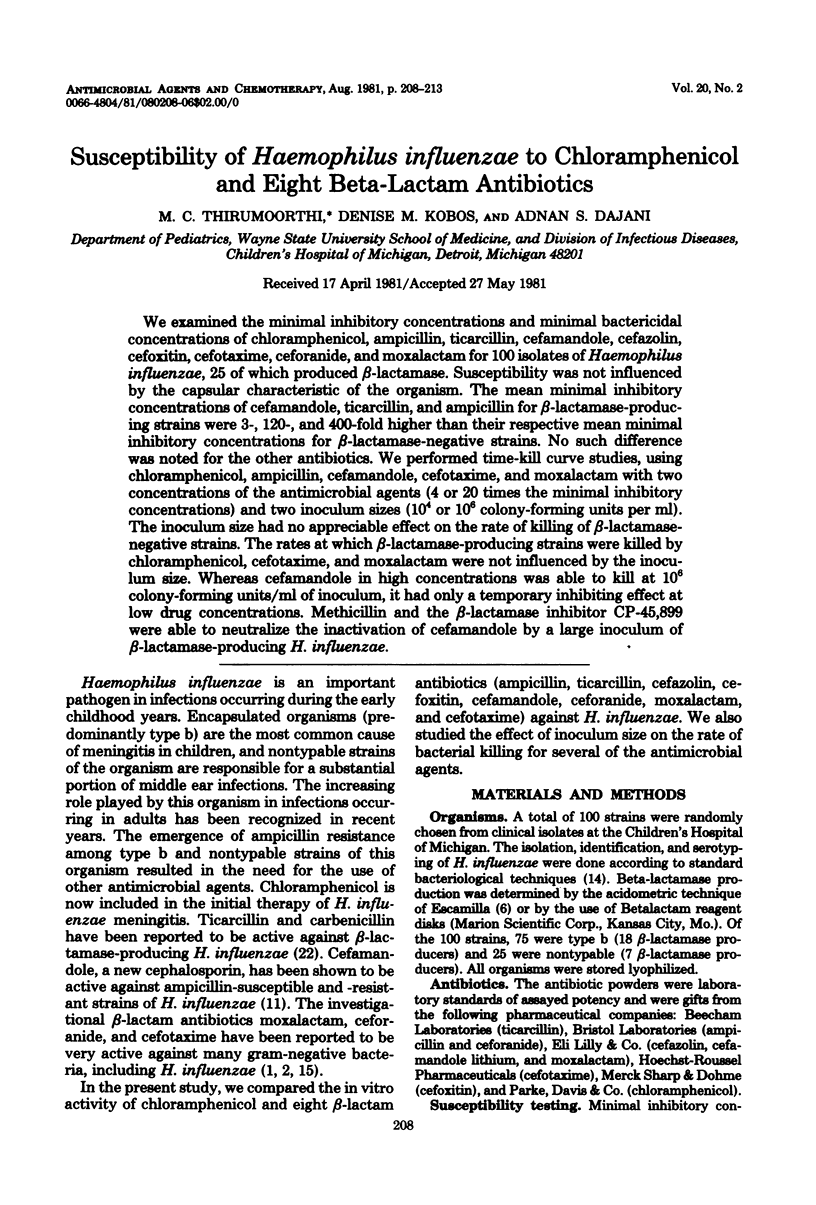
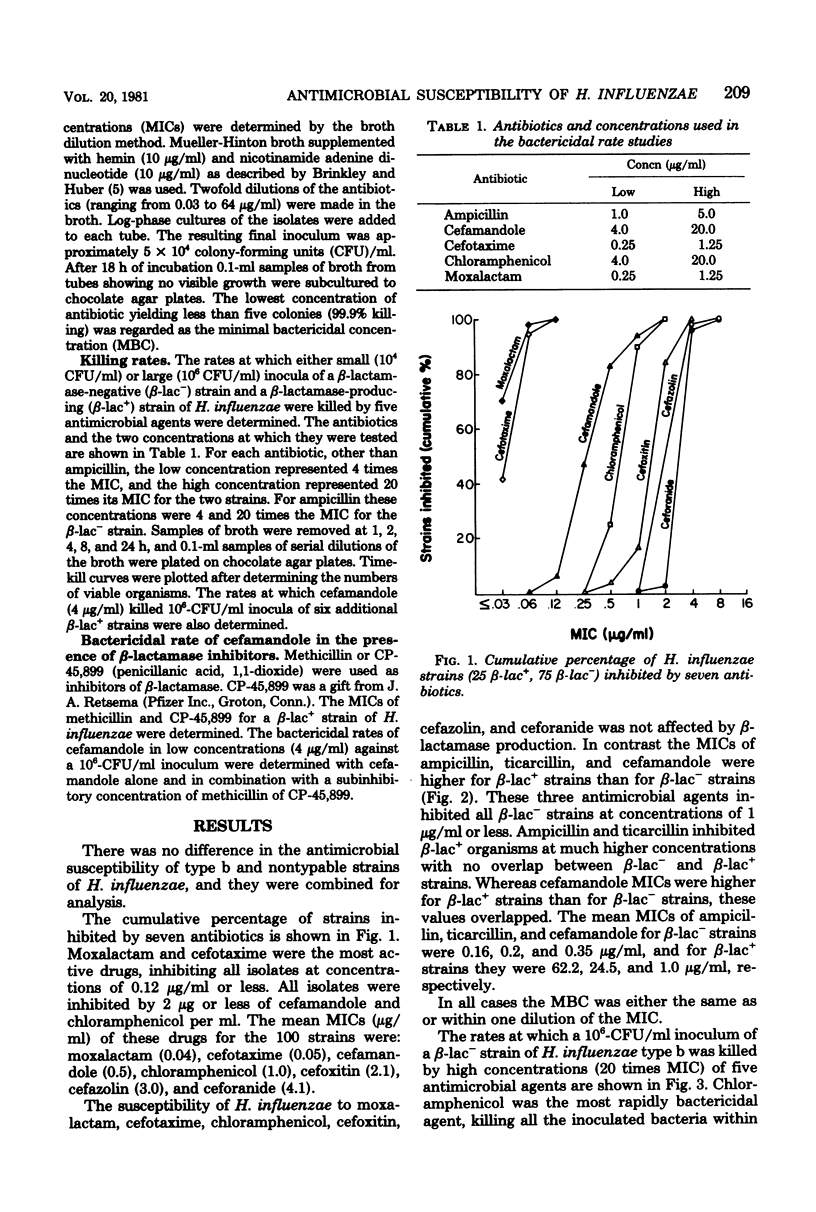
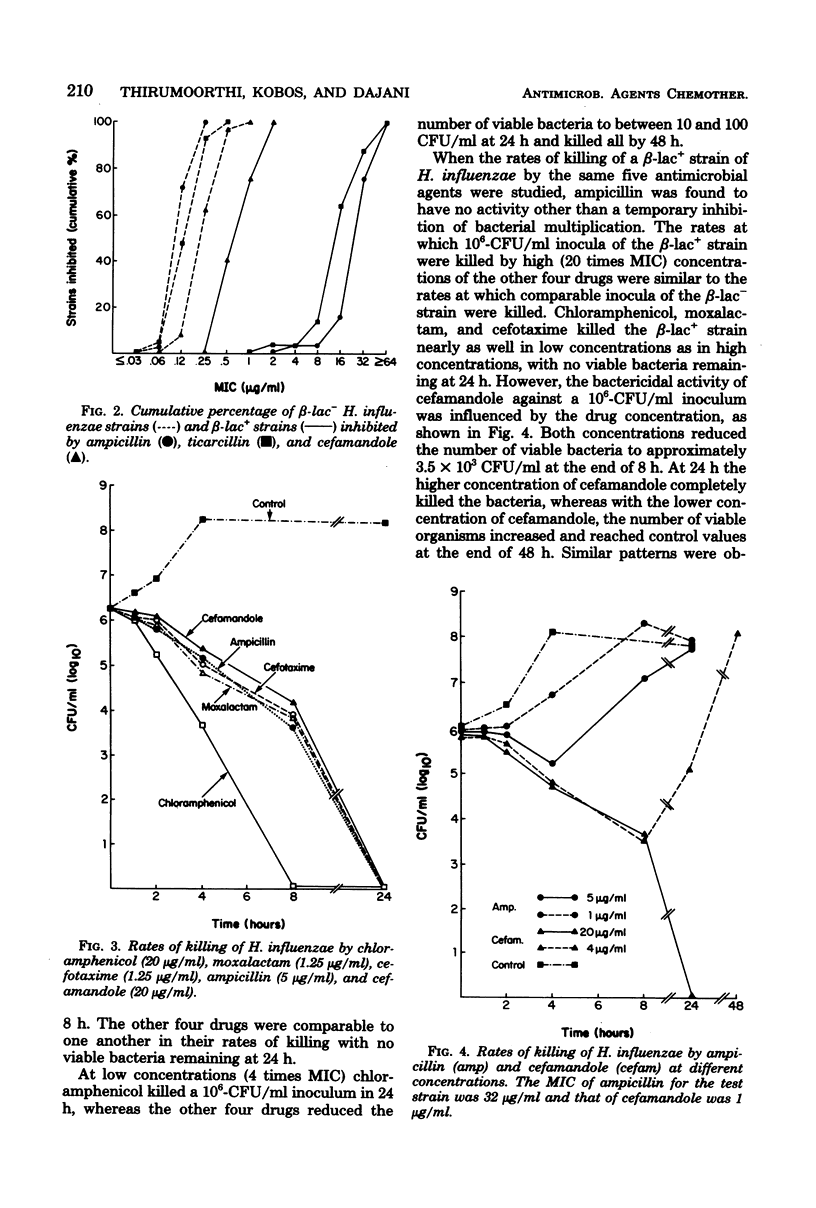
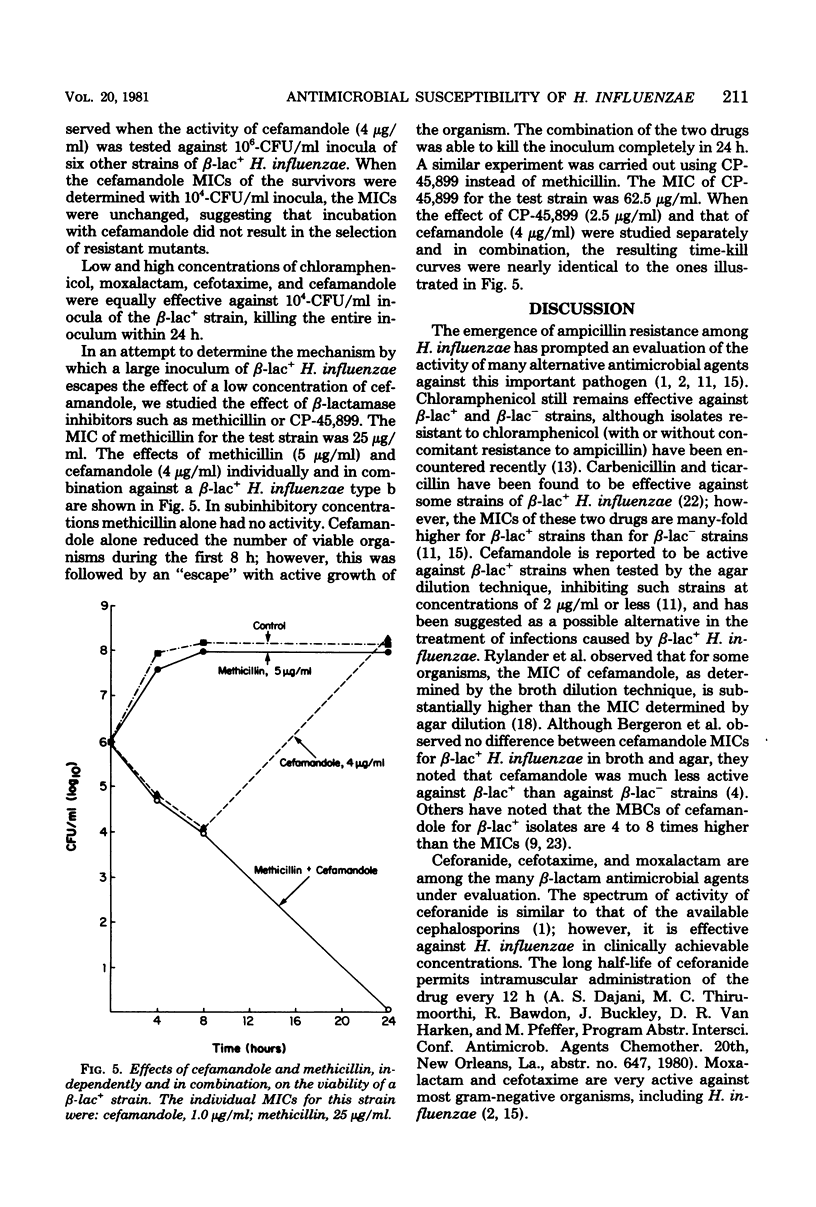

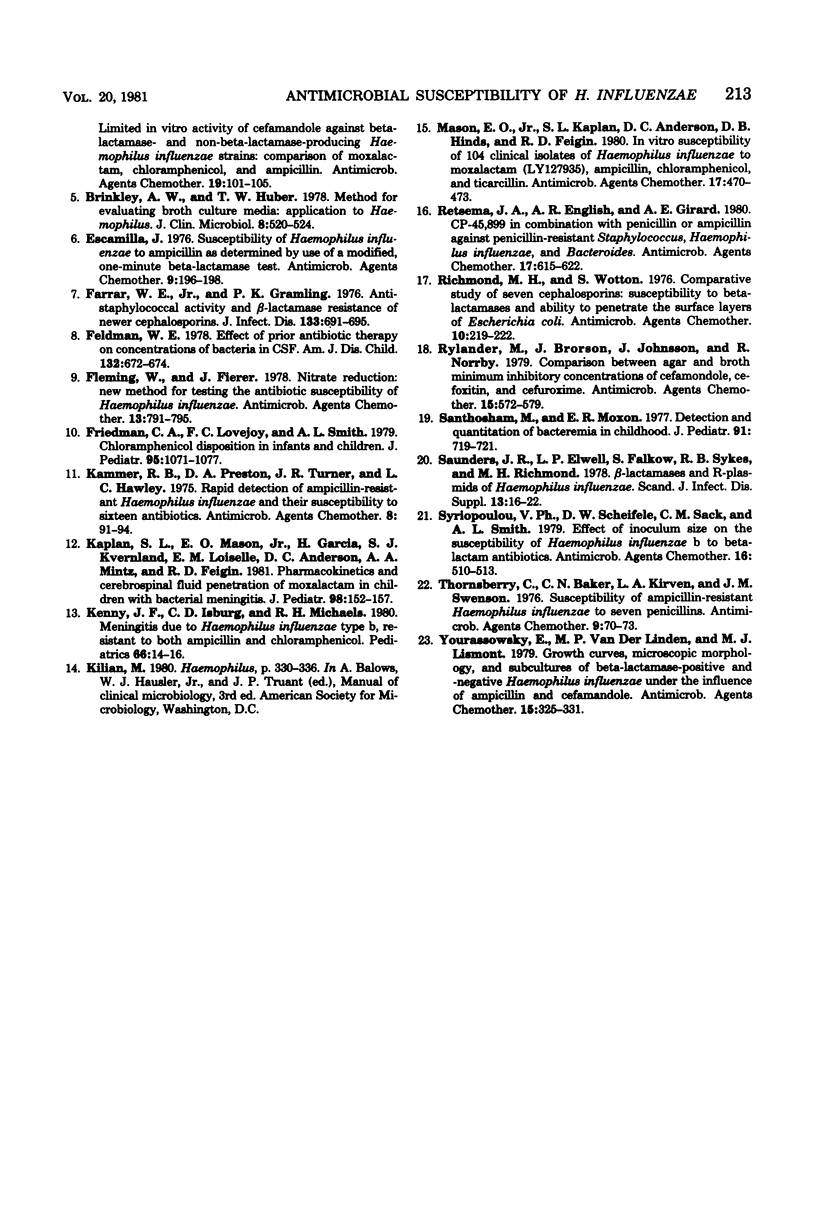
Selected References
These references are in PubMed. This may not be the complete list of references from this article.
- Aswapokee N., Aswapokee P., Fu K. P., Neu H. C. In vitro activity and beta-lactamase stability of BL-S786 compared with those of other cephalosporins. Antimicrob Agents Chemother. 1978 Jul;14(1):1–5. doi: 10.1128/aac.14.1.1. [DOI] [PMC free article] [PubMed] [Google Scholar]
- Baker C. N., Thornsberry C., Jones R. N. In vitro antimicrobial activity of cefoperazone, cefotaxime, moxalactam (LY127935), azlocillin, mezlocillin, and other beta-lactam antibiotics against Neisseria gonorrhoeae and Haemophilus influenzae, including beta-lactamase-producing strains. Antimicrob Agents Chemother. 1980 Apr;17(4):757–761. doi: 10.1128/aac.17.4.757. [DOI] [PMC free article] [PubMed] [Google Scholar]
- Belohradsky B. H., Bruch K., Geiss D., Kafetzis D., Marget W., Peters G. Intravenous cefotaxime in children with bacterial meningitis. Lancet. 1980 Jan 12;1(8159):61–63. doi: 10.1016/s0140-6736(80)90491-2. [DOI] [PubMed] [Google Scholar]
- Bergeron M. G., Claveau S., Simard P. Limited in vitro activity of cefamandole against 100 beta-lactamase- and non-beta-lactamase-producing Haemophilus influenzae strains: comparison of moxalactam, chloramphenicol, and ampicillin. Antimicrob Agents Chemother. 1981 Jan;19(1):101–105. doi: 10.1128/aac.19.1.101. [DOI] [PMC free article] [PubMed] [Google Scholar]
- Brinkley A. W., Huber T. W. Method for evaluating broth culture media: application to Haemophilus. J Clin Microbiol. 1978 Nov;8(5):520–524. doi: 10.1128/jcm.8.5.520-524.1978. [DOI] [PMC free article] [PubMed] [Google Scholar]
- Escamilla J. Susceptibility of Haemophilus influenza to ampicillin as determined by use of a modified, one-minute beta-lactamase test. Antimicrob Agents Chemother. 1976 Jan;9(1):196–198. doi: 10.1128/aac.9.1.196. [DOI] [PMC free article] [PubMed] [Google Scholar]
- Farrar W. E., Jr, Gramling P. K. Antistaphylococcal activity and beta-lactamase resistance of newer cephalosporins. J Infect Dis. 1976 Jun;133(6):691–695. doi: 10.1093/infdis/133.6.691. [DOI] [PubMed] [Google Scholar]
- Feldman W. E. Effect of prior antibiotic therapy on concentrations of bacteria in CSF. Am J Dis Child. 1978 Jul;132(7):672–674. doi: 10.1001/archpedi.1978.02120320032006. [DOI] [PubMed] [Google Scholar]
- Fleming W., Fierer J. Nitrate reduction: new method for testing the antibiotic susceptibility of Haemophilus influenzae. Antimicrob Agents Chemother. 1978 May;13(5):791–795. doi: 10.1128/aac.13.5.791. [DOI] [PMC free article] [PubMed] [Google Scholar]
- Friedman C. A., Lovejoy F. C., Smith A. L. Chloramphenicol disposition in infants and children. J Pediatr. 1979 Dec;95(6):1071–1077. doi: 10.1016/s0022-3476(79)80315-7. [DOI] [PubMed] [Google Scholar]
- Kammer R. B., Preston D. A., Turner J. R., Hawley L. C. Rapid detection of ampicillin-resistant Haemophilus influenzae and their susceptibility to sixteen antibiotics. Antimicrob Agents Chemother. 1975 Jul;8(1):91–94. doi: 10.1128/aac.8.1.91. [DOI] [PMC free article] [PubMed] [Google Scholar]
- Kaplan S. L., Mason E. O., Jr, Garcia H., Kvernland S. J., Loiselle E. M., Anderson D. C., Mintz A. A., Feigin R. D. Pharmacokinetics and cerebrospinal fluid penetration of moxalactam in children with bacterial meningitis. J Pediatr. 1981 Jan;98(1):152–157. doi: 10.1016/s0022-3476(81)80562-8. [DOI] [PubMed] [Google Scholar]
- Kenny J. F., Isburg C. D., Michaels R. H. Meningitis due to Haemophilus influenzae type b resistant to both ampicillin and chloramphenicol. Pediatrics. 1980 Jul;66(1):14–16. [PubMed] [Google Scholar]
- Mason E. O., Jr, Kaplan S. L., Anderson D. C., Hinds D. B., Feigin R. D. In vitro susceptibility of 104 clinical isolates of Haemophilus influenzae to moxalactam (LY127935), ampicillin, chloramphenicol, and ticarcillin. Antimicrob Agents Chemother. 1980 Mar;17(3):470–473. doi: 10.1128/aac.17.3.470. [DOI] [PMC free article] [PubMed] [Google Scholar]
- Retsema J. A., English A. R., Girard A. E. CP-45,899 in combination with penicillin or ampicillin against penicillin-resistant Staphylococcus, Haemophilus influenzae, and Bacteroides. Antimicrob Agents Chemother. 1980 Apr;17(4):615–622. doi: 10.1128/aac.17.4.615. [DOI] [PMC free article] [PubMed] [Google Scholar]
- Richmond M. H., Wotton S. Comparative study of seven cephalosporins: susceptibility to beta-lactamases and ability to penetrate the surface layers of Escherichia coli. Antimicrob Agents Chemother. 1976 Aug;10(2):219–222. doi: 10.1128/aac.10.2.219. [DOI] [PMC free article] [PubMed] [Google Scholar]
- Rylander M., Brorson J. E., Johnsson J., Norrby R. Comparison between agar and broth minimum inhibitory concentrations of cefamandole, Cefoxitin, and cefuroxime. Antimicrob Agents Chemother. 1979 Apr;15(4):572–579. doi: 10.1128/aac.15.4.572. [DOI] [PMC free article] [PubMed] [Google Scholar]
- Santosham M., Moxon E. R. Detection and quantitation of bacteremia in childhood. J Pediatr. 1977 Nov;91(5):719–721. doi: 10.1016/s0022-3476(77)81022-6. [DOI] [PubMed] [Google Scholar]
- Saunders J. R., Elwell L. P., Falkow S., Sykes R. B., Richmond M. H. beta-lactamases and R-plasmids of Haemophilus influenzae. Scand J Infect Dis Suppl. 1978;(13):16–22. [PubMed] [Google Scholar]
- Syriopoulou V. P., Scheifele D. W., Sack C. M., Smith A. L. Effect of inoculum size on the susceptibility of Haemophilus influenzae b to beta-lactam antibiotics. Antimicrob Agents Chemother. 1979 Oct;16(4):510–513. doi: 10.1128/aac.16.4.510. [DOI] [PMC free article] [PubMed] [Google Scholar]
- Thornsberry C., Baker C. N., Kirven L. A., Swenson J. M. Susceptibility of ampicillin-resistant Haemophilus influenzae to seven penicillins. Antimicrob Agents Chemother. 1976 Jan;9(1):70–73. doi: 10.1128/aac.9.1.70. [DOI] [PMC free article] [PubMed] [Google Scholar]
- Yourassowsky E., Van Der Linden M. P., Lismont M. J. Growth curves, microscopic morphology, and subcultures of beta-lactamase-positive and -negative Haemophilus influenzae under the influence of ampicillin and cefamandole. Antimicrob Agents Chemother. 1979 Mar;15(3):325–331. doi: 10.1128/aac.15.3.325. [DOI] [PMC free article] [PubMed] [Google Scholar]


